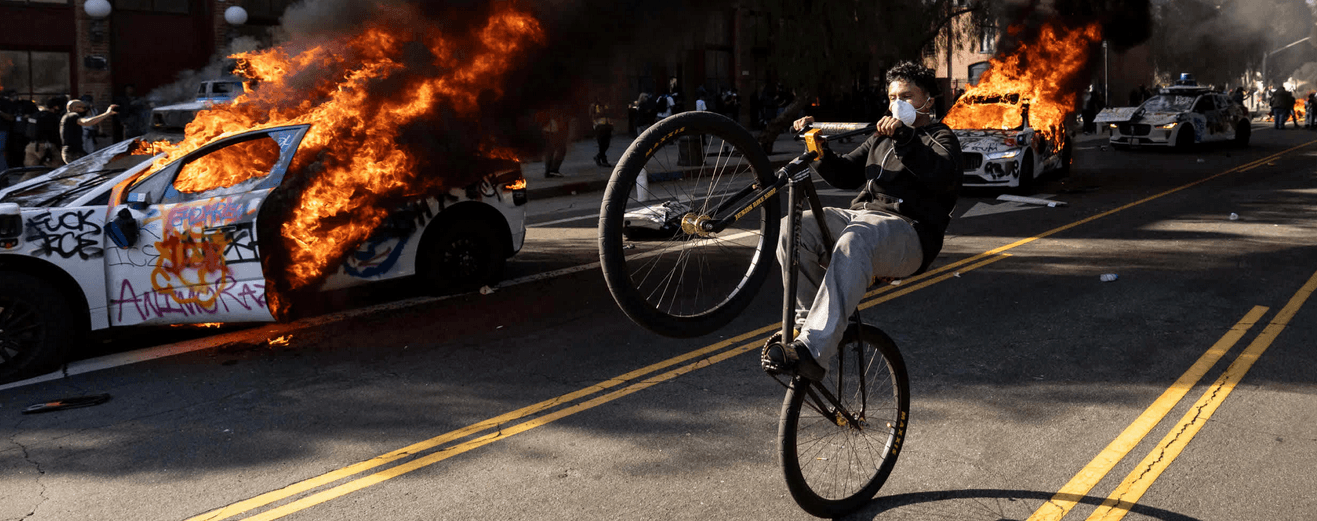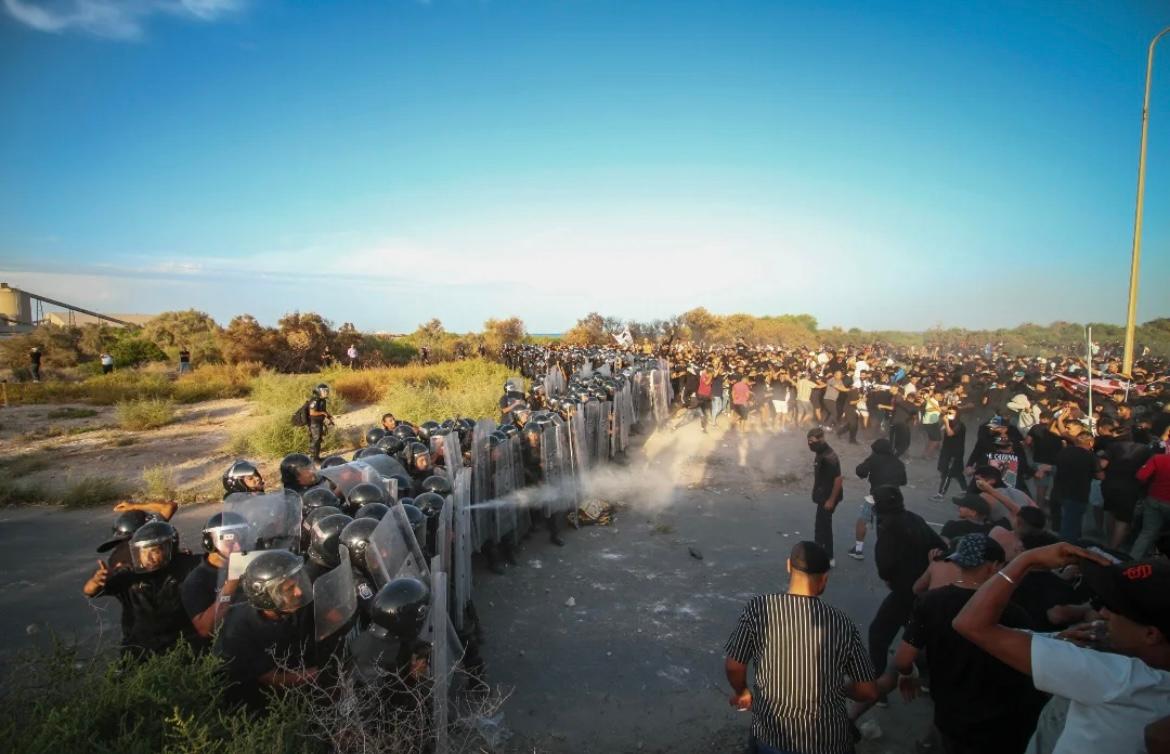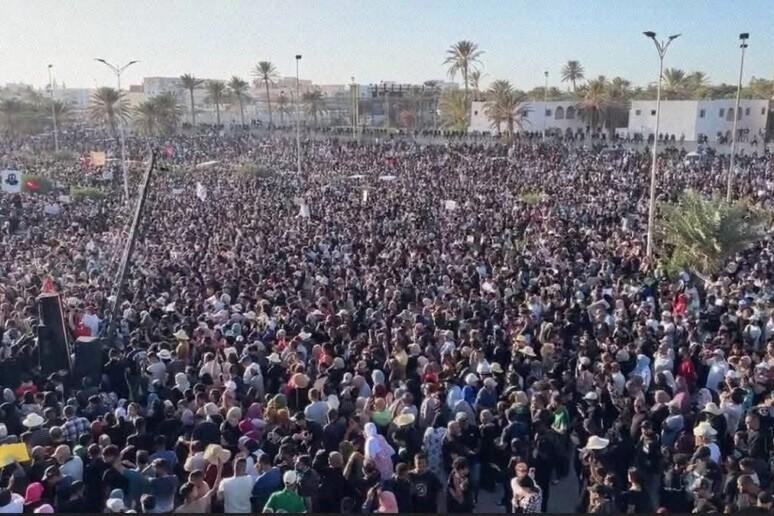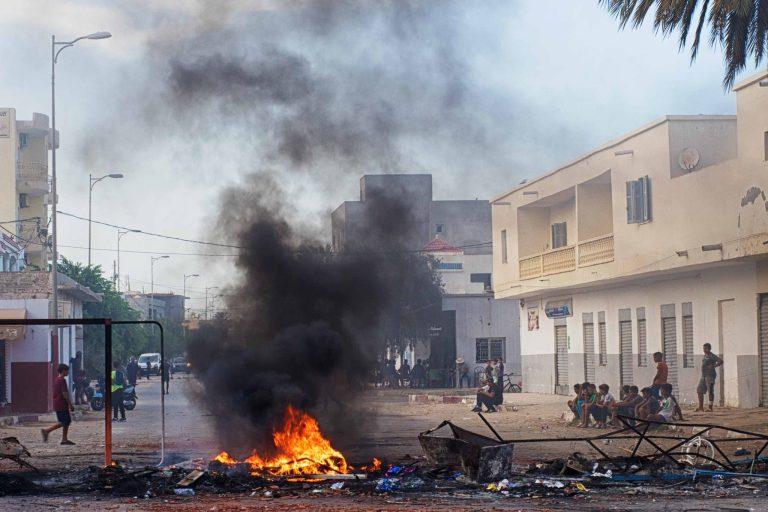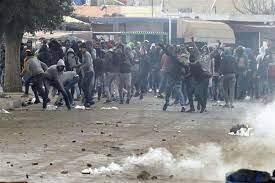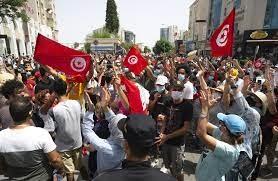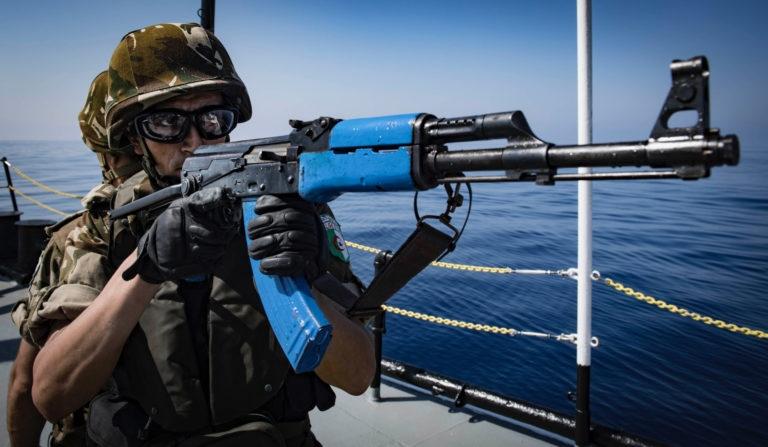
NOTES ON THE TUNISIAN CLASS STRUGGLES
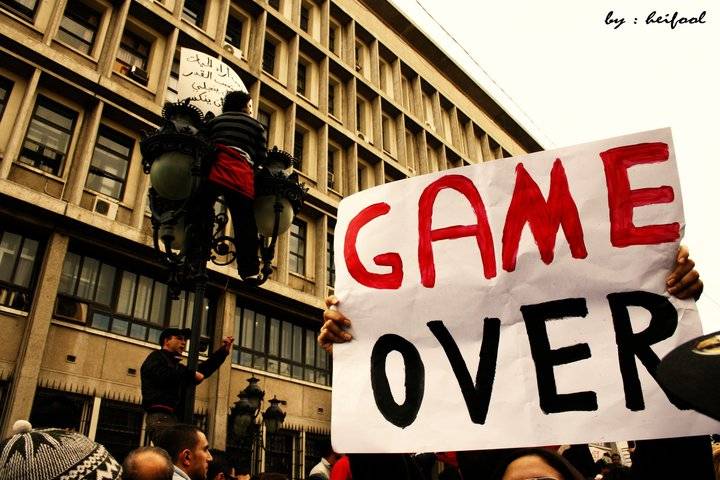
From the right to escape to the right to resist.
The corollary describes the movement of the working class which, when able and willing to do so, struggles and organizes by deploying conflict in the social territory of origin or, on the contrary, chooses to fight by organizing its movement, heading elsewhere [Y.M. Boutang] following the routes of migration which in the North African case directly are struggles against Fortress Europe, against its strategies for governing the movement of living labour.
Recent events in Tunisia shouldn’t deceive us: we are not dealing with a sudden burst but rather with a change of direction of a permanent conflict that until recently preferred to present itself as migration, and that today, in Tunisia, has chosen to interfere and emerges in its territory (how powerfully! And with such a groundbreaking drive!). In short, the exercise of the right to escape (for which one also pays the price of drowning in the Mediterranean Sea, of internments in detention centres and of exploitation in European production) has been succeeded by the practice of the right to resistance, organized and acted in an offensive manner against the regime of Carthage and its post-colonial vassal in the sphere under European influence.
A generation against the regime of crisis.
The Tunisian regime is a clientelist political machine organized in order to violently and brutally expropriate the wealth produced by the manual and knowledge workers on a market where 80% of the trade runs between Tunisia and the countries of the European Union. The extreme poverty produced by the system of trade with the EU is matched only by the wealth that the Tunisian establishment has enjoyed for decades by means of a police state free to choke and suppress any possible outbreak of the poor, of the dispossessed, of the plundered. This orientation of the economic policies of the Tunisian regime is not an invention of the lobbies whose leader for more than 20 years has been Ben Ali but goes back to the choices made by Habib Bourguiba, right after the crisis in the 70s, that led the old despot to abandon the cooperativist nature of the development policies that characterized the socialism of the Destour regime towards the Tunisian entry on the then emerging neo-liberal global market. The economic dependency of the North African region on Europe also gripped Tunisia that apart from setting up larger coastal resorts for European citizens held no other areas of development. It is no coincidence then, that the first days of rebellion unleashed in the region of Sidi Bouzid and that the technical and political composition of the movement to come already was fully mature while, in the city, buildings of public and private institutions were besieged.
Sidi Bouzid, one of the main agricultural centres in Tunisia, has for decades suffered the wild expropriation of wealth without ever having anything in return in terms of development policies and investment in the food and agricultural industry – with the exception, as for the rest of the country, of public education. The crisis of the Euro-Tunisian market and the crisis of sovereign debt have broken the command exercised by the EU and the working class has taken the opportunity to hit the enemy. It’s no longer a struggle against the neoliberal regime of Fortress Europe through migration but class struggle against its local regime within the global space of crisis. The movement of revolt had its initial epicentre and consolidated some of its more consistent and determined social and political bases in a region (localized between Sidi Bouzid, Kesserine and Tahla) where the crisis has shown itself in clear outlines – inside which a high level of educational development has been met by repressive policies of the management of poverty only. It is in this contradiction that the social subjectivity of the young proletariat has been able to seize political energy in order to become a generation-for-itself, carrying out a radical secession from the violent system of misery and poverty and, in this movement of separation, in this affirmation of radical opposition, it has organized the poverty and misery in order to restore dignity to work and to knowledge, involving the multiplicity of struggles against the crisis and against the regime. It is on this tendency of the class composition that the revolutionary becoming of the Tunisian movement levers onto and where the multiplicities of social insurgencies and political intransigence of the class and of civil society have found a remarkable convergence.
The movement’s spaces of organization opened up around these characteristics given by the social composition interweaving the union headquarters with the social networks, with school and faculty assemblies making them become places of reappropriation of political debate and of direct action. We are dealing with the instant transformation of the solidarity committees that spread everywhere after the revolt in Sidi Bouzid on December 17 into real territorial constituent assemblies, institutions of class autonomy, whose offensive resistance and radical antagonism already is an expression of “other” social relations, of another justice and practice of coming democracy.
Tactics to the union…
Ben Ali was shook by the earthquake produced by this constituent and antagonist opposition composed of an immanent plan of organization and continuous struggle, risen overnight with a great leap from the demands for more fair economic policies, to spread over Tunisia as a movement of liberation from the regime and from the capitalist crisis. This sudden change which, having matured through the revolutionary subjectivity, has shown itself in the use of the union where its mid-low rank cadre allowed the movement to impose the strategy and the union to function as tactics.
Union as tactics and general strike as development and continuity of the movement – herein lay the premises of the first major victory of the insurrectional mobilizations that since January have radicalized and grown until the expulsion of Ben Ali. The regime responded with severe repression reaching warlike levels, of rape and of besieged cities and of public executions – in return receiving the continuous confirmation through the planned strikes on behalf of the union, the organization of struggle initiatives and the socialization of discourses and counter-information on behalf of the social networks, the spreading of student assemblies and the agitation of civil society – connected and welded to the class struggle opened up by the social vanguard of education sector in struggle. It’s no longer about the young poor or proletarian youth but of a generation-for-itself oriented towards its own goals and purposes of liberation.
By triggering and making publicly manifest the severe repression of which the Ben Ali regime was capable, the class struggle made its own revolutionary progress mature. The openings to the demands of the movement by the regime through televised speeches by the dictator to the nation (the last one even in pure Tunisian dialect) were read by the movement for what they really were: manifestations of weakness on behalf of the counterpart pressed by the social accumulation of cooperation and counter-power.
The post-Islamist split?
The regime tried, under the full development and spreading of the movement during the days of January, to play the card of manipulation by narrating the revolts as if they were actions carried out by groups linked to radical Islamism referring to terrorist organizations like Al Qaeda Maghreb or to mysterious powers. In this way, wanting on one hand to assure the international political support for the slaughter that was becoming more and more violent under those days and, on the other, playing on the possibility of separation of the secular strata and professions active within and internal to the processes of deployment of the social movement. The massive arrival of statements, declarations and video messages from the most different factions of Islamic fundamentalism came right on time as help for the propaganda of the regime. Facing this event, the movement simply pursued its agenda of struggle in part by ignoring and rejecting, in part by returning any provocative meddling of international Islamism to the sender and by denouncing the work of the regime’s criminalization.
The Tunisian movement shows itself with innovative strength also by creating a first deep crack in the rhetoric and dispositif of capture of mass media power tied to the season of the endless war. Between December and January on the heated squares of Tunisia, emerges a first major and decisive event in an Arab-Muslim country, a post-Islamist and non-fundamentalist mass movement, where the body experiments with the infinite capacities it is capable of, including its liberation from religious discourse.
The Tunisian events put a way out on the agenda, out from the narrative of “war of civilizations” into a “war within civilization”, between the expropriators and the dispossessed. The apparent absence of Islamist organizations in the revolt confirms this.
Annahda, the main Tunisian Islamist organization (that looks upon the Islamic-liberal policies of the Turkish government as model), seems to have been unable to see any chance for realizing its divine mission amongst the rebellious Tunisians, preferring to remain far from the general strikes that led to the dictator’s escape and then, once Ben Ali was chased away, present themselves with extreme opportunism and interested pragmatism, in front of the TV cameras of the West in search for visibility. This is a feature common to the whole political class and opposition parties, including secular and socialist factions more or less recognized by the old regime (with very few exceptions, such as the Tunisian Communist Workers’ Party), that waited as long as until the 9th of January 2011 to come up with a joint statement demanding the dictator an immediate cease-fire in order to “set up a national debate in order to resolve problems and initiate the necessary reforms.”
In the decisive days of the conflict, groups and parties of the socialist tradition, secular, Communist and Green have shown their inability to understand and support the movement failing also to engage, following their own purposes, in the revolutionary process.
In fact, they return on stage after the escape of Ben Ali after being called by the regime trying to put together a so-called interim government towards free elections – an event that was delegitimized and opposed by the movement and the trade union organization that, within hours, withdrew its ministers declaring to not recognize the new government.
The transition: the army, the militia and the groups of territorial self-defence.
14 January was the date of the general strike when the forces that had been gathering under the month of revolt of the Tunisian movement unleashed. After a day of clashes the movement manages to scare away the tyrant and the army enters the stage. The military, stationed in all the cities of the country since January in order to maintain a sort of neutral position between the police and the demonstrators, manages to muster plenty of support from the latter ones, setting themselves up as the only and last institution capable of functioning as a final link between the population and the State. Hence it is the army of conscripts that takes control over the cities and defends the institutional frame during the transition after Ben Ali.
Minister Ghannouchi, an important man of the regime who in 2006 was pointed out as a possible successor to Ben Ali by the American embassy in Tunis, takes the dictator’s place and declares publicly that he is working to build a government able to arrange free elections and to take measures in order to restrain the advancement of the movement’s demands for liberation.
At this stage, the Tunisian establishment develops a political and then military attack on the movement. Those who are called to form a new government are more or less well-known persons from the opposition parties and civil society, ministers from the previous Ben Ali government as well as a few men from the regime party (RCD) also making up a part, amnesties are announced and internet censorship is lifted. Within hours, the trade union (UGTT) pulls back its men from the government in distrust publicly giving an organized expression to the will of the movement and reconfirming itself as the tactical instrument of the revolutionary processes.
Its not by chance then, that the union after the mistrust towards the government publicly supports and encourages the forming of territorial defence groups being organized from the solidarity committees widely spread over Tunisia and centres of elaboration of the initiative. These groups are the movement’s response to actions carried out by the armed militia – composed of policemen, criminals and RCD militants most loyal to Ben Ali – who after the escape of the dictator began to act as paramilitary squads trying to bring terror into the working-class areas and banlieus by setting homes and small shops on fire, attacking the trade union offices and provoking sit-ins and demonstrations, shooting wildly in the neighbourhoods, all with the aim to hit the areas inhabited by the social vanguard of the movement. The forming of groups of territorial self-defence has become an effective means of social and political defence against the attempts of terrorist neutralization and armed repression of the movement, guaranteeing the protection of the social autonomy conquered through struggle and organized by the solidarity committees.
Southern governance in crisis.
The entry of the militia on the scene and of a no-longer discreet “activism” on behalf of the army are in parallel with the resumption of initiative of the Western powers’ coming out from the post-Ben Ali trauma. Europe finds itself deprived of an important economical partner in the North African context and of a trusted ally in political and military initiatives to counter migration and Islamist radicalism. Without the vassal of Carthage, Europe – and especially France and Italy – loses yet another stabile share of influence in the Mediterranean area; pressed from the South, in Sudan, by the anti-Chinese offensive of the White House, and in East by an Egyptian government in open crisis thanks to the progressive formation of a social movement against the establishment led by Mubarak and against the high costs of living. What remains for the European Union is Algeria, linked by pipelines pumping oil and gas to the old continent but the social context does not promise long-term stability worrying the White House who after the overthrow of Ben Ali sent an envoy in order to discuss the situation with Algerian ministers. For Italy, the last Western country to turn its back against Ben Ali, Gaddafi is the key player in the Mediterranean if they are to maintain a role (at least) on the international arena and to retain weight on this arena, thus deepening the politics towards Libya.
It is also because of these reasons that Europe never has waved the flag of human rights or civil liberties in the face of Ben Ali and his police State. Much less did they care to scold the vassal of Carthage while his police force suppressed the revolts of the first days of January with ferocious violence. The European Union is terrorized by the possibility that a Southern front may open up in the Mediterranean area, and now that they are wrestling with the sovereign debt crisis they cannot look without an extreme fear over a destabilized Maghreb that does not originate from radical Islamist activism (still manageable, although not without difficulties, in the context of the so-called “war against terrorism”), but from social insurgencies or, as in the case of Tunisia, from the class struggles’ opening up of spaces capable of sweeping away heads of state and of turning institutional frames upside down.
If the tendency that takes shape in terms of class composition and emerging subjectivity is orientated towards a Maghreb united through struggles, the proletariat may take advantage of the European weakness that cannot do without falling back upon Washington in order to politically limit or crush (in military terms) the struggles of reappropriation and conflict in the Maghrebi area of the global crisis. Its no surprise, then, that the American ambassador in Tunis on 20th January 2011 released an official announcement which, apart from Obama’s statement (who just days before praised the democratic renewal of the Tunisian people), directly supported the Ghannouchi government’s plans of “transition”, recommending the Tunisians to proceed “peacefully and responsibly” with the assurance that the United States “stands with you as you make the transition to a peaceful and stable democracy”.
The White House, by supporting the new government that it never intended to be brought about by a popular uprising aims to halt the Tunisian movement. A movement that still may surprise, supported by a global hacker militancy able to guarantee communication among the rebellious, to defend the information flow between the revolt and the rest of the world and to carry out information attacks to put out the official communication even in such a critical situation where the counterpart is in no lack of initiatives.
A struggling generation makes headway in the Mediterranean.
The exercise of the right to resist against the regime of crisis in Tunisia continues rejecting the tragicomic pseudo gains offered to the square by the opposition parties still remaining within the Ghennouchi government. The movement is coherently following its own purposes, its own great aims for liberation and now that the tyrant is chased away, it is working to liberate itself from tyranny.
The defence of its own constituent institutions and the attack on the continuation of the violent system of expropriation that had condemned the majority of workers and unemployed to poverty are the tendencies around which the initiative concentrates, showing that there is an “other” counter-constitution in becoming. The deepening and consolidating of the class autonomy developed by the struggling education sector which has been able to centralize the multiplicity of proletarian struggles and of civil society by organizing them in a combined effort against the regime.
There are no longer any “youths” in Tunisia or, rather, governed youth but a generation-for-itself playing the main role in the struggle for its possible liberation, capable of organizing poverty in order to bring back dignity to work and to knowledge, making an immediately other crisis-antagonist cooperation. This tendency knows the face of a burning Mohammad – an unemployed holding a degree in economy selling fruits and vegetables in order to earn a living – it knows the face of any university researcher busy delivering pizza in the evenings or the face of that precarious worker who, holding a diploma, is working at yet another unpaid internship. This tendency breaks the frontiers of Fortress Europe and Maghreb, not just in proletarian imagination but also in the materiality of the class composition, which can make the Mediterranean a place of struggle and organization instead of governance of migration. The class struggles in Tunisia say this as well and, let aside their further development, already have realized something that proletarians of the whole world gaze at. Strategy to the movement, tactics to the trade union and in the strike the affirmation of social relations antagonistic to the regime of crisis – this is the original innovation produced in only a few days by a proletariat that for years and up until this point was forced into silence and misery.
The clash is precisely at this level today: in between the pressure of the movement’s constituent praxis and the attempt of the elites to through repression and openings neutralize (in perfect Ben Ali style) the instances of transformation affirmed by the crowds. The clash today stands between a constitution, that of the regime, which needs to be reformed in order to guarantee the establishment and the interests of the Western powers and another coming constitution continuously founding itself on the relations that the movement produces and reproduces outside and against the State valorisation of the now old regime that remains. The trade union continues to function as a tactical instrument in this context and large parts of civil society are in movement in the orbit of the class struggles of the generation-for-itself, which may drag in other regions through the innovation of a first non-fundamentalist and post-Islamist revolutionary becoming. The destabilizing effects of this event – which could become a process elsewhere – on the Arab regimes and Western powers will not delay the repression of the local and global party of reaction.
Whether the alternative is military or a possible recuperation of the revolutionary process from above, they will have to deal with a struggling generation that has preferred the exercise of the right to resistance to the right to escape making the proletarians of the whole world discover the offensive power of poverty, when religion is left in the skies while struggling and organizing on the ground in order to take back everything here and now.
Translated by Kemal Kamel and Thanks to Michele Masucci for proofreading
Ti è piaciuto questo articolo? Infoaut è un network indipendente che si basa sul lavoro volontario e militante di molte persone. Puoi darci una mano diffondendo i nostri articoli, approfondimenti e reportage ad un pubblico il più vasto possibile e supportarci iscrivendoti al nostro canale telegram, o seguendo le nostre pagine social di facebook, instagram e youtube.



